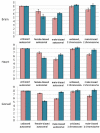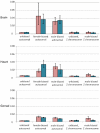The unique genomic properties of sex-biased genes: insights from avian microarray data
- PMID: 18377635
- PMCID: PMC2294128
- DOI: 10.1186/1471-2164-9-148
The unique genomic properties of sex-biased genes: insights from avian microarray data
Abstract
Background: In order to develop a framework for the analysis of sex-biased genes, we present a characterization of microarray data comparing male and female gene expression in 18 day chicken embryos for brain, gonad, and heart tissue.
Results: From the 15982 significantly expressed coding regions that have been assigned to either the autosomes or the Z chromosome (12979 in brain, 13301 in gonad, and 12372 in heart), roughly 18% were significantly sex-biased in any one tissue, though only 4 gene targets were biased in all tissues. The gonad was the most sex-biased tissue, followed by the brain. Sex-biased autosomal genes tended to be expressed at lower levels and in fewer tissues than unbiased gene targets, and autosomal somatic sex-biased genes had more expression noise than similar unbiased genes. Sex-biased genes linked to the Z-chromosome showed reduced expression in females, but not in males, when compared to unbiased Z-linked genes, and sex-biased Z-linked genes were also expressed in fewer tissues than unbiased Z coding regions. Third position GC content, and codon usage bias showed some sex-biased effects, primarily for autosomal genes expressed in the gonad. Finally, there were several over-represented Gene Ontology terms in the sex-biased gene sets.
Conclusion: On the whole, this analysis suggests that sex-biased genes have unique genomic and organismal properties that delineate them from genes that are expressed equally in males and females.
Figures






Similar articles
-
Rapid evolution of female-biased, but not male-biased, genes expressed in the avian brain.Mol Biol Evol. 2007 Dec;24(12):2698-706. doi: 10.1093/molbev/msm208. Epub 2007 Sep 24. Mol Biol Evol. 2007. PMID: 17893399
-
All dosage compensation is local: gene-by-gene regulation of sex-biased expression on the chicken Z chromosome.Heredity (Edinb). 2009 Mar;102(3):312-20. doi: 10.1038/hdy.2008.116. Epub 2008 Nov 5. Heredity (Edinb). 2009. PMID: 18985062
-
Emergence of male-biased genes on the chicken Z-chromosome: sex-chromosome contrasts between male and female heterogametic systems.Genome Res. 2011 Dec;21(12):2082-6. doi: 10.1101/gr.119065.110. Epub 2011 Aug 25. Genome Res. 2011. PMID: 21868722 Free PMC article.
-
Sex determination and gonadal sex differentiation in the chicken model.Int J Dev Biol. 2018;62(1-2-3):153-166. doi: 10.1387/ijdb.170319cs. Int J Dev Biol. 2018. PMID: 29616724 Review.
-
The evolution of sex-biased genes and sex-biased gene expression.Nat Rev Genet. 2007 Sep;8(9):689-98. doi: 10.1038/nrg2167. Epub 2007 Aug 7. Nat Rev Genet. 2007. PMID: 17680007 Review.
Cited by
-
Lack of dosage compensation accompanies the arrested stage of sex chromosome evolution in ostriches.Mol Biol Evol. 2013 Apr;30(4):806-10. doi: 10.1093/molbev/mst009. Epub 2013 Jan 16. Mol Biol Evol. 2013. PMID: 23329687 Free PMC article.
-
Transcriptomic Analyses Reveal Novel Genes with Sexually Dimorphic Expression in Yellow Catfish (Pelteobagrus fulvidraco) Brain.Mar Biotechnol (NY). 2015 Oct;17(5):613-23. doi: 10.1007/s10126-015-9650-z. Epub 2015 Aug 5. Mar Biotechnol (NY). 2015. PMID: 26242754 Free PMC article.
-
The scope and strength of sex-specific selection in genome evolution.J Evol Biol. 2013 Sep;26(9):1841-53. doi: 10.1111/jeb.12201. Epub 2013 Jul 13. J Evol Biol. 2013. PMID: 23848139 Free PMC article.
-
Sex-biased gene expression on the avian Z chromosome: highly expressed genes show higher male-biased expression.PLoS One. 2012;7(10):e46854. doi: 10.1371/journal.pone.0046854. Epub 2012 Oct 3. PLoS One. 2012. PMID: 23056488 Free PMC article.
-
Sex-specific differences in transcriptome profiles of brain and muscle tissue of the tropical gar.BMC Genomics. 2017 Apr 7;18(1):283. doi: 10.1186/s12864-017-3652-3. BMC Genomics. 2017. PMID: 28388875 Free PMC article.
References
Publication types
MeSH terms
Substances
LinkOut - more resources
Full Text Sources
Molecular Biology Databases
Miscellaneous

